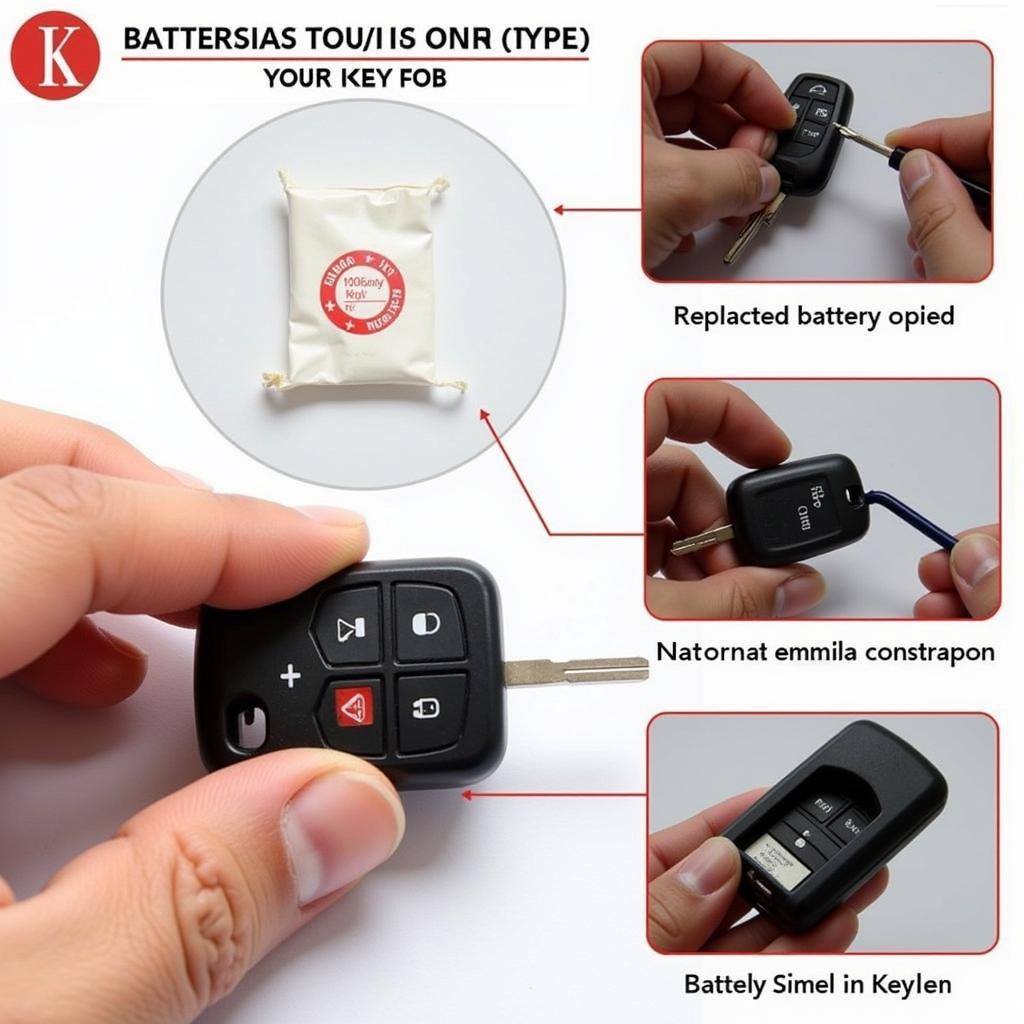A malfunctioning key fob can be frustrating, leaving you stranded and unable to access your vehicle. Fortunately, many key fob issues can be resolved with simple troubleshooting steps. This comprehensive guide explores common problems, potential causes, and how to fix a key fob, restoring its functionality.
Understanding Key Fob Problems
Before delving into solutions, it’s crucial to identify the specific issue with your key fob. Common symptoms include:
- Key fob not unlocking/locking the car: This could indicate a dead battery, signal interference, or a programming error.
- Intermittent functionality: The key fob may work sporadically due to a weak battery, loose connections, or internal component damage.
- Reduced range: A weak battery or a faulty antenna can shorten the key fob’s operational range.
- Buttons not responding: Physical damage, worn-out buttons, or internal circuitry problems can render the buttons unresponsive.
Common Causes and DIY Fixes
Here’s a breakdown of common causes and DIY fixes for key fob issues:
1. Key Fob Battery Low
A dead or dying battery is the most common culprit behind key fob malfunctions.
Solution:
- Consult your car’s manual to identify the battery type and location within the key fob.
- Carefully open the key fob casing using a small screwdriver or a coin (if applicable).
- Replace the old battery with a new one, ensuring correct polarity.
- Reassemble the key fob and test its functionality.
Tip: For a visual guide on replacing a Toyota key fob battery, check out this helpful resource: how to replace toyota key fob battery.
2. Key Fob Programming Errors
A key fob might fail to communicate with your car if it’s not programmed correctly.
Solution:
Reprogramming often requires a specific sequence of actions within the car, such as turning the ignition on and off, pressing certain buttons, or using a designated programming port.
Important: Consult your owner’s manual or seek professional assistance for accurate reprogramming procedures, as they vary significantly between car manufacturers and models.
3. Signal Interference
Radio frequencies from other electronic devices or systems in close proximity can interfere with the signal between your key fob and car.
Solution:
- Move away from potential sources of interference, such as mobile phones, laptops, or security gates.
- Try using the key fob closer to the car’s receiver (usually located near the windshield or within the door handles).
4. Faulty Key Fob Antenna
A damaged or malfunctioning antenna in either the key fob or the car can disrupt the signal transmission, leading to reduced range or complete failure.
Solution:
- Inspect the key fob’s antenna for any visible damage. If it’s a separate component, ensure it’s securely connected.
- Diagnosing and repairing a car antenna often requires professional expertise and specialized tools.
5. Internal Component Damage
Physical impact from dropping, water damage, or wear and tear can damage the key fob’s internal components, affecting its functionality.
Solution:
- If you suspect internal damage, it’s best to consult a qualified automotive locksmith or dealership for diagnosis and repair. They can assess the damage and advise on whether repair or replacement is more cost-effective.
When to Seek Professional Help
While some key fob issues are easily resolvable with DIY methods, certain situations warrant professional assistance:
- Suspected internal damage: Diagnosing and repairing internal components require specialized knowledge and tools.
- Key fob programming issues: Incorrect programming can potentially damage the vehicle’s immobilizer system, leading to further complications.
- Unfamiliarity with car electronics: If you’re uncomfortable handling electronic components or unsure about any step, it’s best to err on the side of caution.
Preventing Key Fob Problems
Proactive measures can extend your key fob’s lifespan and minimize the risk of future issues:
- Regularly check and replace the battery: Don’t wait for the battery to die completely before replacing it.
- Handle with care: Avoid dropping the key fob or exposing it to extreme temperatures or moisture.
- Use a protective case: A key fob cover can provide an extra layer of protection against physical damage.
- Keep it away from strong magnetic fields: Prolonged exposure to strong magnets can interfere with the key fob’s circuitry.
Conclusion
Knowing how to fix a key fob empowers you to address minor issues and regain control of your vehicle. By following the troubleshooting tips and understanding when to seek professional help, you can keep your key fob functioning optimally for years to come. If you’ve changed the key fob battery and are still experiencing problems, it’s advisable to explore further solutions or consult a professional to diagnose and address the issue effectively. For more information on common key fob issues, you can visit our articles on key fob battery low and key fob is not working.
FAQs
Q1. How long does a key fob battery last?
A: On average, a key fob battery lasts between 3 to 5 years, depending on usage and environmental factors.
Q2. Can I program a key fob myself?
A: While some vehicles allow for DIY programming, many require specialized equipment or dealer intervention. Refer to your owner’s manual for specific instructions.
Q3. What should I do if my key fob is lost or stolen?
A: Contact your dealership or a qualified automotive locksmith immediately to disable the lost key fob and program a replacement to prevent unauthorized access to your vehicle.
Q4. Are there any alternatives if my key fob stops working completely?
A: Most modern cars have a hidden key slot or a mechanical key release mechanism. Consult your owner’s manual to locate and use these backup options.
Q5. Does my car insurance cover key fob replacement?
A: Coverage for key fob replacement varies depending on your insurance policy. Contact your insurance provider to understand your coverage details.


